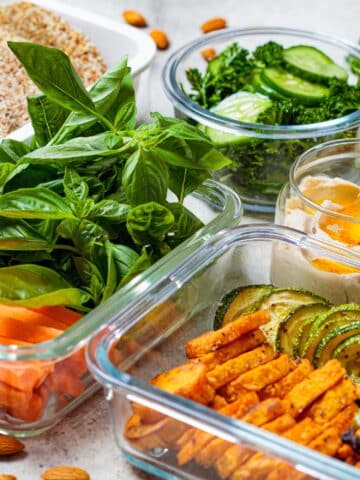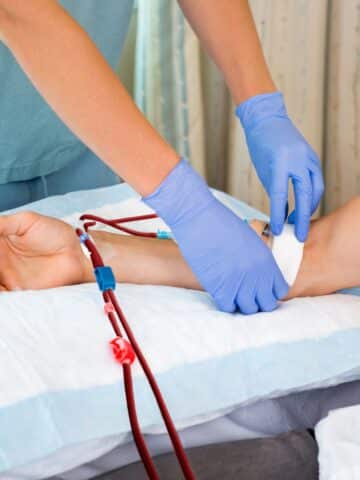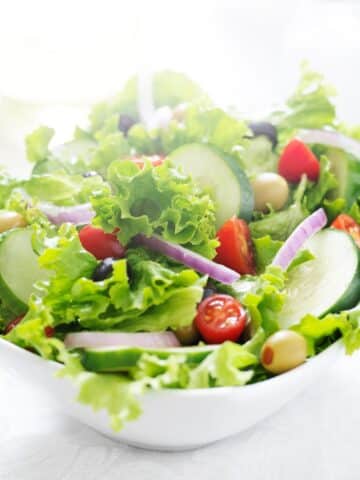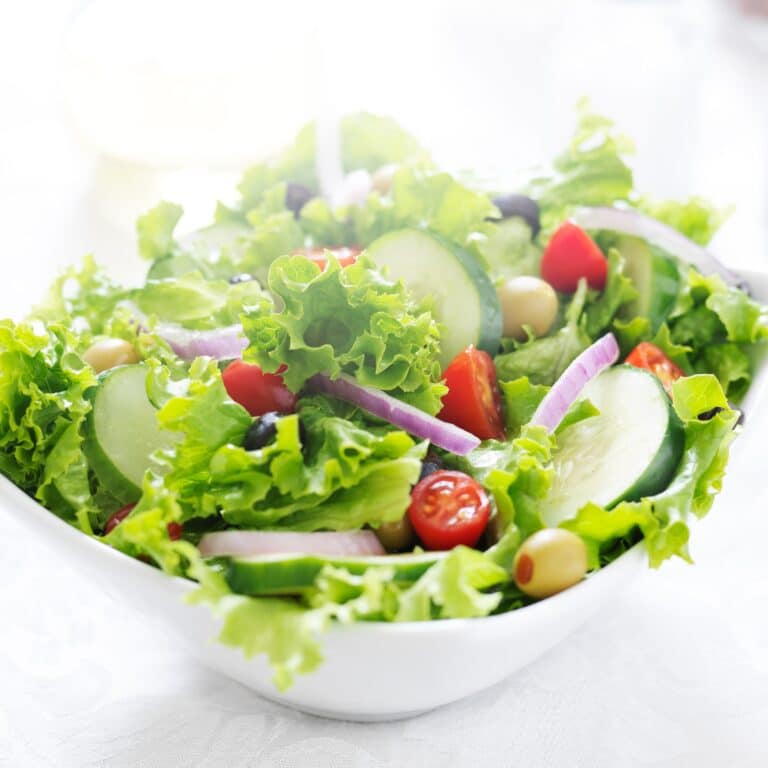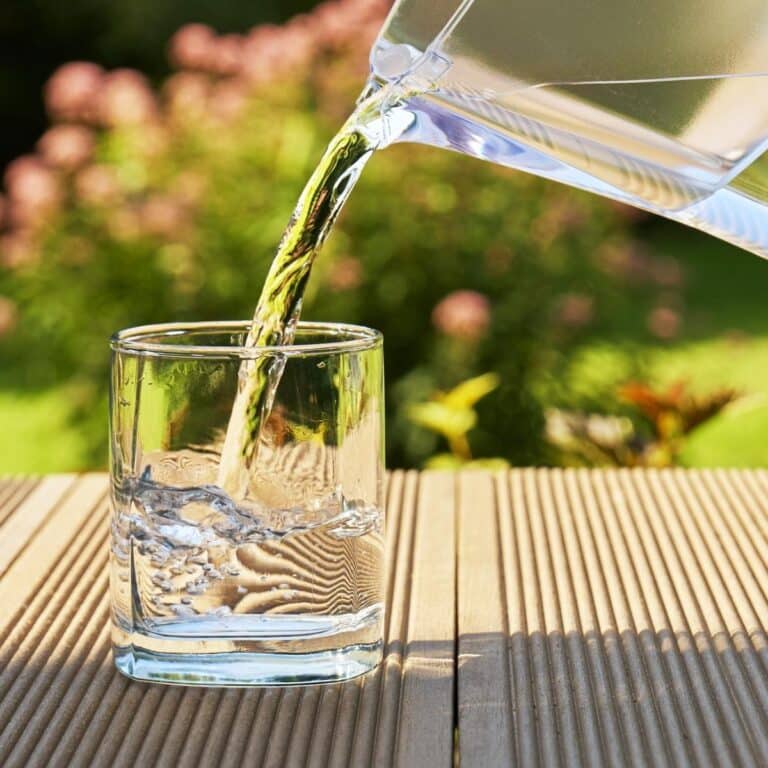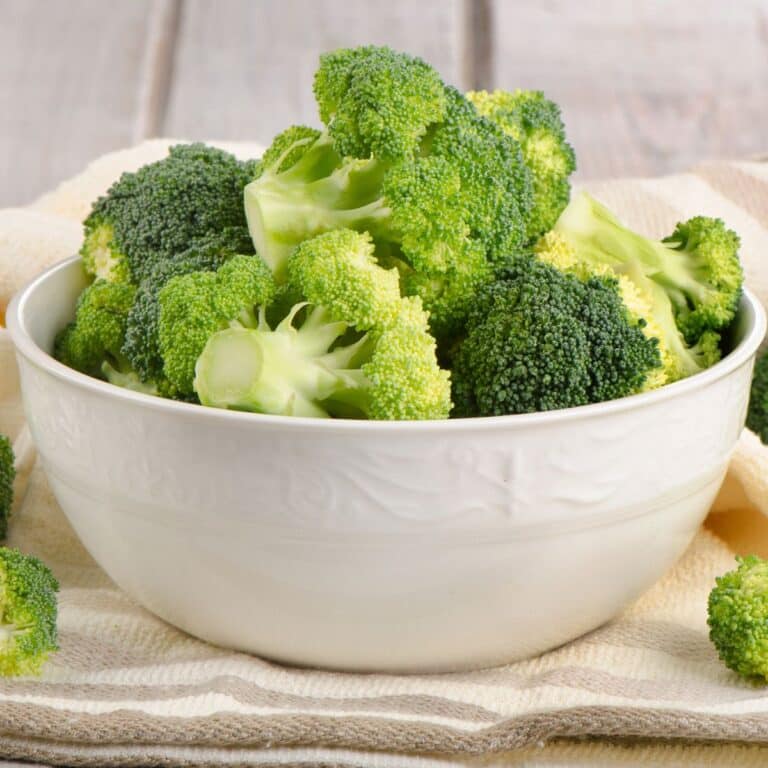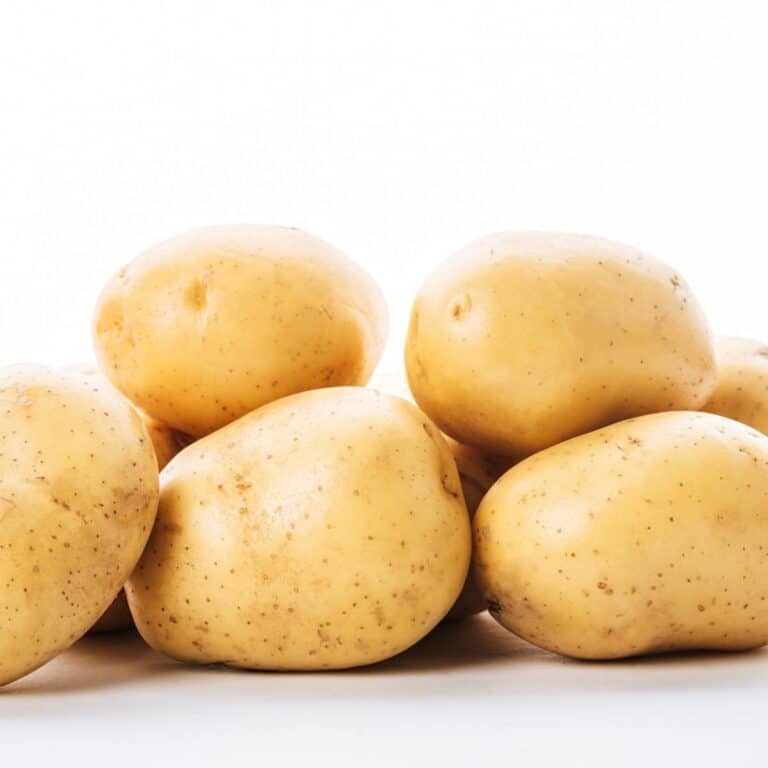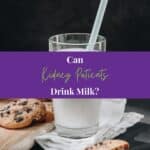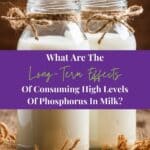Phosphorus In Milk
Milk is a staple in many diets worldwide, providing essential nutrients to keep us healthy and energized. But did you know that milk also contains phosphorus?
Phosphorus is an important mineral that plays a role in the body's growth and development, as well as protecting our bones and teeth.
When you have (chronic kidney disease (CKD), phosphorus levels can become dangerously high because your kidneys can’t filter it effectively.
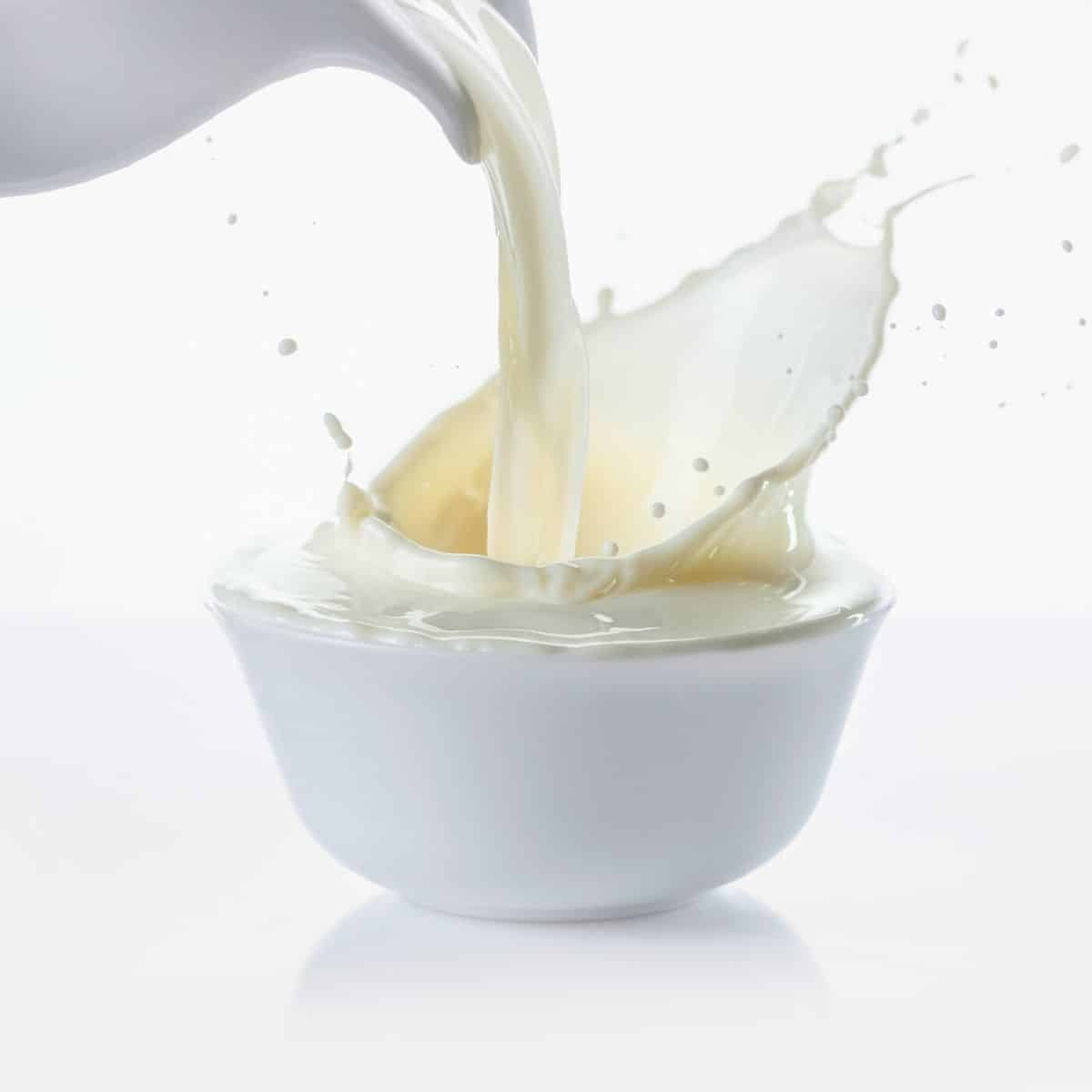
The result is extra phosphorus in your blood. High phosphorus levels leach calcium from your bones. This process can cause calcium deposits in blood vessels, lungs, eyes, and heart.
Over time this can lead to increased risk of heart attack, stroke, or death with people with kidney disease.
For patients on a renal diet, the question is…do you need to give up milk and dairy? What source of phosphorus is best from food?
In this article, we'll explore how much phosphorus is found in different types of milk, why it's so beneficial for our bodies, and what potential risks may be associated with excessive phosphorus intake from dairy products and kidney disease.
Jump to:
- Overview Of Phosphorus In Milk
- Amount Of Phosphorus In Milk
- Phosphorus Content In Almond Milk
- Is Oat Milk High In Phosphorus?
- Other Low Phosphorus Milk Alternatives
- Organic Vs Inorganic Phosphorus
- Natural Sources Of Phosphorus
- Benefits Of Low Phosphorus Milk
- FAQs for Phosphorous in Milk
- Choose The Best Low Phosphorus Milk For You
Overview Of Phosphorus In Milk
Phosphorus is an important mineral found in milk, and it has a variety of health benefits. Its content is important to consider when consuming milk, as too much can be detrimental to health especially for people with kidney disease.
The benefits of consuming milk with the right amount of phosphorus include improved bone health and digestion, as well as better nerve and muscle function. Understanding the phosphorus content in milk and the associated health benefits is key to making sure it's consumed in the proper amount.
For More Recipes and Ideas --->> Get Your Free Meals and Recipes That Are Perfect for Pre-Dialysis Diets, Pre-Dialysis with Diabetes, or Dialysis Diets.
Phosphorus Content
Phosphorus can be found in both cow’s milk and many other types of milk substitutes. Let's take a look at the role of phosphorus in milk as well as its other sources.
Phosphorus absorption from cow’s milk depends on several factors such as its concentration, calcium content and individual differences between people. While some studies suggest that dairy-based foods are generally better sources of bioavailable phosphorus than plant-based options, this isn't always the case.
If someone has dietary restrictions due to allergies or intolerance, they may need to consider taking supplements to increase their intake. Is oat milk good for kidney disease? Luckily, there are plenty of plant-based milk alternatives to cow’s milk like soy, almond and oat milks which can also provide phosphorus.
Health Benefits
Adequate levels of phosphorus are essential for overall health due to its various benefits. Phosphorus supports bone health, immune system function, body maintenance, and brain development.
It plays a vital role in bone mineralization, preventing conditions like osteoporosis. Phosphorus also aids in the production of immune cells, ensuring a strong immune system.
It contributes to energy production, supports organ function, and maintains cellular health. Additionally, phosphorus is involved in regulating pH levels, synthesizing DNA and RNA, and facilitating proper brain development.
Maintaining a balanced phosphorus intake is crucial for optimizing health and well-being. Yes, there are steps to improving kidney health that you can take.
Amount Of Phosphorus In Milk
Milk is a great source of phosphorus, so it's important to know how much is in it. Testing for the amount of phosphorus in milk is quite simple, and can be done in a lab.
However, high amounts of phosphorus in milk can be a health risk especially for those with kidney damage, so it's important to keep an eye on it.
Most of the phosphorus in milk comes from the animal's diet, so that's something to consider in testing. High levels of phosphorus in the body can cause issues like kidney stones, so it's important to monitor.
Moreover, consuming milk with too much phosphorus can also lead to calcium deficiency, so it's best to keep an eye on it.
Sources Of Phosphorus In Milk
It's no secret that milk is a great source of phosphorus -- but have you ever stopped to think about where it comes from?
Fortified milk, dairy substitutes and the pasteurization process all play an important part in ensuring we get this essential nutrient. Let’s dive into how these sources can help us maintain a healthy nutrient balance.
Fortified milk has become increasingly popular as it contains more nutrients than regular cow’s milk (coffee creamer for renal diet). This type of milk is often enriched with vitamin D and calcium – two minerals which are key components for strong bones and teeth.
It also includes added phosphorus, helping us meet our daily recommended intake. Understanding the renal diet milk process is so important.
Plant-based milk options such as almond or soy milks are also fortified with vitamins, including phosphorus, making them a great option for those who suffer from lactose intolerance or simply want to switch up their diet.
The pasteurization process used on many types of store-bought milks can sometimes cause some loss of certain micronutrients; however in most cases it does not affect the amount of phosphorus found naturally within the product.
Testing For Phosphorus In Milk
Testing for phosphorus in milk is an important step to ensure that we are getting the right amount of this essential mineral. We can test different types of milks, such as skimmed and whole cow's milk, to find out their calcium content and how much phosphorus they contain.
There are also dairy-free alternatives available which have been fortified with additional amounts of vitamins, including phosphorus. This makes it easier for those who suffer from lactose intolerance or simply want to switch up their diet.
Testing the levels of phosphorus in milk is typically done using various analytical methods. One common method is the colorimetric assay, which involves the reaction of phosphorus with specific reagents to produce a colored complex.
The intensity of the color is then measured using a spectrophotometer, and the phosphorus concentration is determined based on the absorbance.
Another method is the enzymatic assay, where enzymes specific to phosphorus are used to catalyze reactions that produce a measurable signal. This signal is then correlated to the phosphorus concentration in the milk.
These methods enable accurate and reliable quantification of phosphorus levels, ensuring quality control and nutritional analysis of milk products.
It's important to pay attention to nutrition facts labels when grocery shopping so you can select products with phosphorus content based on your needs.
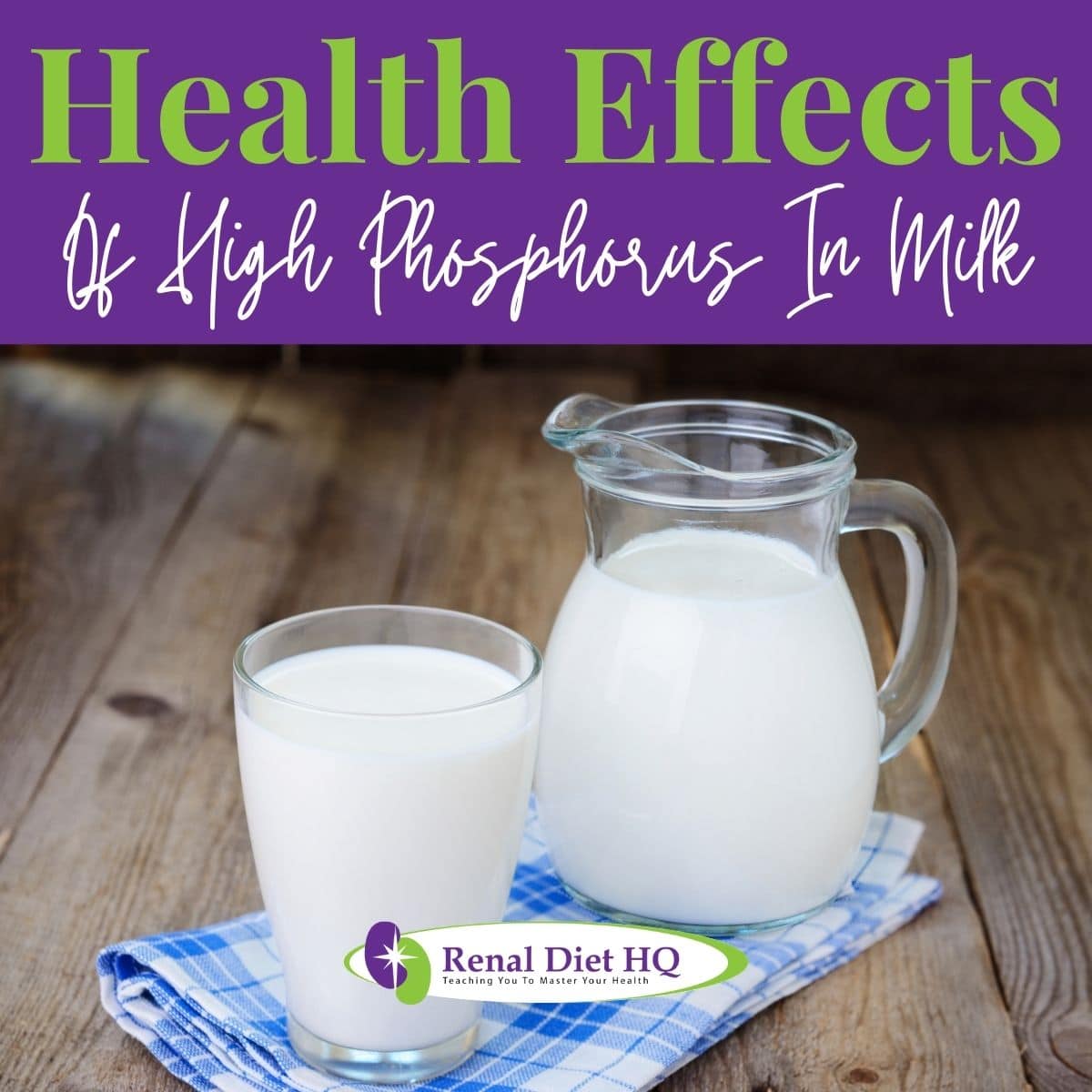
Health Effects Of High Phosphorus In Milk
High phosphorus levels in milk can have significant health effects, particularly for individuals with chronic kidney disease. CKD patients have impaired kidney function, making it difficult for their bodies to filter and excrete excess phosphorus.
Regular consumption of milk high in phosphorus can lead to hyperphosphatemia, a condition characterized by abnormally elevated phosphorus levels in the blood.
Hyperphosphatemia in CKD patients can have detrimental consequences. It disrupts the delicate balance between phosphorus and calcium, leading to a decrease in serum calcium levels.
In response, the body releases parathyroid hormone (PTH) to regulate calcium, resulting in secondary hyperparathyroidism. Prolonged elevated PTH levels can lead to bone mineral loss, increased risk of fractures, and skeletal abnormalities.
Furthermore, high phosphorus levels contribute to stiffening of blood vessels, which can increase the risk of cardiovascular complications in CKD patients. Excess phosphorus deposits in blood vessels, leading to the hardening and narrowing of arteries, compromising overall cardiovascular health.
To manage phosphorus levels, CKD patients are often advised to follow a low-phosphorus diet, which includes reducing or avoiding high-phosphorus dairy products like milk. They may also be prescribed with phosphorus binders, medications that bind to dietary phosphorus in the gut to prevent its absorption.
By carefully monitoring and controlling phosphorus intake, CKD patients can minimize the health risks associated with high phosphorus levels in milk and other foods.
Phosphorus Content In Almond Milk
First, let's discuss the types of almond milk available. There's regular, unsweetened, and fortified almond milk, just to name a few. Next, we should look at the phosphorus levels in each type.
Types Of Almond Milk
Almond milk comes in various types, each catering to different dietary preferences and needs. One type is unsweetened almond milk, which contains no added sugars and is often favored by those looking for a low-calorie, low-carbohydrate option.
Another variety is sweetened almond milk, which has added sweeteners for a slightly sweeter taste. For individuals with dietary restrictions, there are also options such as vanilla-flavored almond milk or chocolate almond milk, providing additional flavors and versatility.
Additionally, there are almond milk varieties (almond milk and kidney disease) specifically formulated for those with lactose intolerance or dairy allergies, offering a dairy-free alternative. Some brands also offer almond milk with added nutrients like calcium or vitamin D, providing additional health benefits.
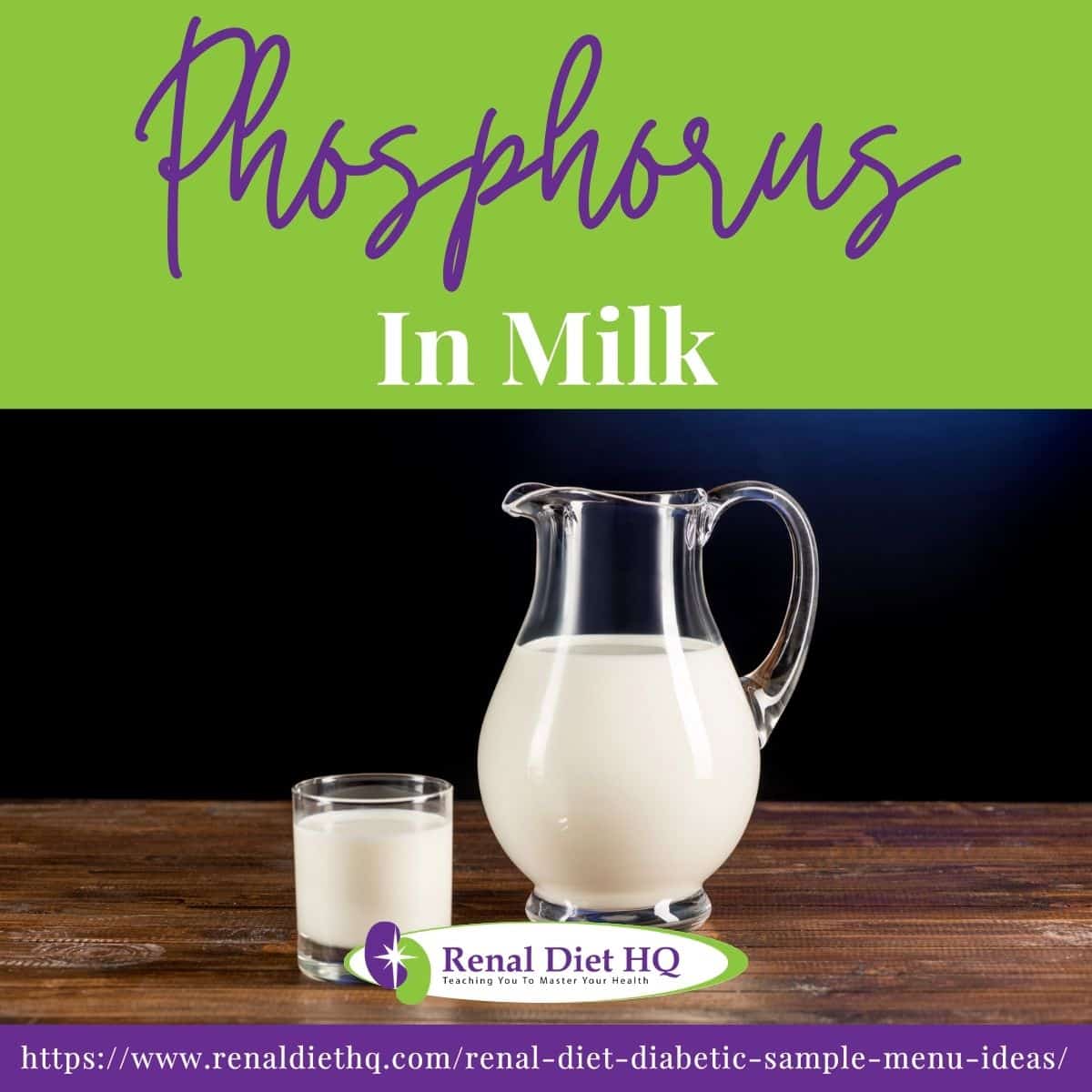
Phosphorus Levels
There are various types of almond milk available in the market, each with its own phosphorus content. Here is a summary showcasing the phosphorus content of different almond milk varieties per cup (240 ml):
- Unsweetened almond milk: Approximately 24 mg of phosphorus.
- Sweetened almond milk: The phosphorus content varies depending on the brand and amount of added sweeteners, typically ranging from 20 mg.
- Flavored almond milk (e.g., vanilla or chocolate): Similar to sweetened almond milk, the phosphorus content may vary, typically falling within the range of 20 mg.
- Fortified almond milk: Some brands offer almond milk fortified with additional nutrients like calcium and vitamin D. The phosphorus content in fortified almond milk can vary but is generally around 30-40 mg.
It is important to note that the phosphorus content may vary among different brands, so it is advisable to check the nutrition labels for accurate information.
Individuals with specific dietary needs or conditions, such as chronic kidney disease, should consult with a healthcare professional for guidance on appropriate phosphorus intake.
Is Oat Milk High In Phosphorus?
Does oat milk have potassium? Generally, oat milk is high in phosphorus when compared to other alternative milk products. However, when compared to milk from dairy cattle, oatmeal milk may be slightly lower in phosphorus. As exact phosphorus content may vary per brand, it is best to always check the food labels.
Oat Milk Nutrition
Oatmeal is one of the most popular breakfast items for vegetarians and those with dietary restrictions. It's a great source of fiber, protein, vitamins, and minerals – including phosphorus.
Oat milk offers a range of nutritional benefits that make it a popular alternative to traditional dairy milk. With only 120 calories per cup, oat milk provides a moderate calorie content. The 5g of fat in oat milk comes from lipid fats and contains no saturated or trans fats, making it a healthier option.
Oat milk has 16g of carbohydrates, which may be higher compared to other milk products, but the carbs primarily come from fiber rather than simple sugars. This high fiber content sets oat milk apart, offering a substantial 1.9g of fiber per serving, unlike cow's milk that contains no fiber at all.
While oat milk provides less protein compared to cow's or soy milk, with 3g per serving, it offers more protein compared to other milk substitutes like almond or rice milk. This can be particularly beneficial for individuals following vegan (vegan renal diet recipes) or dairy-free diets.
Oat milk also contains important vitamins and minerals such as thiamin, folate, copper, zinc, manganese, magnesium, and trace amounts of various vitamins. Commercially available oat milk is typically fortified with essential vitamins A, D, B12, and B2, enhancing its nutritional profile.
Phosphorus In Oat Milk
Oat milk contains a moderate amount of phosphorus, with approximately 269 mg per cup, which corresponds to around 20% of an adult's daily value (DV).
While this phosphorus content is not excessively high, it is worth noting for individuals with kidney disease. People with kidney disease often have difficulty regulating phosphorus levels in their bodies, and high phosphorus intake can lead to complications.
Therefore, those with kidney disease should be mindful of their overall phosphorus intake, including from sources like oat milk.
It is advisable for individuals with kidney disease to consult with their healthcare provider or a registered dietitian to determine the appropriate phosphorus limits and ensure they follow a balanced diet that supports their specific needs.
Other Low Phosphorus Milk Alternatives
For individuals with chronic kidney disease, managing phosphorus levels is crucial for maintaining their health. In this context, low phosphorus milk alternatives can be valuable options.
Aside from almond milk and oat milk, soy milk, rice milk, and coconut milk (coconut and ckd) are popular alternatives to dairy milk that can provide a low phosphorus content. These plant-based milks offer a variety of flavors and nutritional profiles, making them suitable choices for individuals with specific dietary restrictions.
By incorporating low phosphorus milk alternatives into their diet, CKD patients can enjoy a range of options while ensuring they adhere to their phosphorus control regimen.
Soy Milk
Soy milk is one of the well known low phosphorus milk alternatives. Soybeans are highly nutritious, providing essential vitamins and minerals along with protein and fiber. Plus, they contain phytoestrogens which may reduce cholesterol levels and protect against cardiovascular disease.
However, some people have allergies or sensitivities to soy products so it's important to check nutrition labels carefully before consuming them.
Soy milk has approximately 126 mg of phosphorus per cup, making it a good option for patients with kidney disease.
Moreover, soy milk has also shown promising effects on phosphorus and calcium metabolism. A study compared the impact of replacing milk with soymilk or calcium-fortified soymilk on postprandial serum phosphorus levels.
The results indicated that serum phosphorus levels decreased the most after consuming the soy milk meal, compared to the milk meal (chronic kidney disease diet food list).
Interestingly, the study also found that the postprandial elevation in serum phosphorus levels was suppressed when milk was replaced with soymilk, even when the soymilk contained the same amount of calcium as milk.
These findings suggest that incorporating soymilk as a part of a meal may have desirable effects on phosphorus regulation, making it a potentially beneficial choice for individuals with specific dietary concerns, such as those with chronic kidney disease.
Rice Milk
Rice milk (unenriched rice milk) is a non-dairy milk alternative made from milled rice and water. It is naturally lactose-free, making it suitable for individuals with lactose intolerance or those following a dairy-free diet.
In addition, rice milk has gained attention as a low phosphorus milk alternative for people with kidney disease. With approximately 137 mg of phosphorus per cup, rice milk offers a lower phosphorus content compared to cow's milk. This can be advantageous for individuals with compromised kidney function who need to monitor their phosphorus intake.
By incorporating rice milk into their diet, individuals with kidney disease can enjoy a nutritious and flavorful milk alternative without significantly impacting their phosphorus levels.
While some milks may not be a safe option, rice milk is. Rice Dream is a good brand, and the classic has about 30 mg per half cup. Their enriched, however, has more than twice that. Make sure to read labels!
Because phosphorus levels aren’t always included in the nutrition label, it’s important to look at the ingredients list. The following may be indicated in the label for phosphorus additives:
- Calcium phosphate
- Disodium phosphate
- Phosphoric acid
- Monopotassium phosphate
- Dipotassium phosphate
- Sodium acid pyrophosphate
- Sodium tripolyphosphate
Coconut Milk
Coconut milk is rich in vitamins and minerals, and it's a great source of protein and healthy fats. It may have some kidney health benefits too, as it's naturally low in phosphorus. Plus, it can provide essential nutrients like magnesium and calcium that may help support kidney function.
Coconut milk is a plant based milk and is a lower phosphorus option. It has 127 mg of phosphorus per half cup. However, there are other alternative milks that have lower phosphorus content.
Imagine how you can enjoy the creamy, sweet taste of coconut milk without compromising your kidney health. Plant based milks like coconut are an excellent dairy substitute for those with lactose intolerance and provide many nutrients that help support a healthy lifestyle.
Coconut milk is an ideal for calcium absorption due to its high content in magnesium which helps improve bone strength, making it a better alternative than soy-based alternatives when it comes to calcium intake. It also contains minimal amounts of sodium, which be hard on kidneys if consumed in large quantities.
Organic Vs Inorganic Phosphorus
There are two different types of phosphorus, organic and inorganic. Organic phosphorus is naturally occurring in plant and animal sources, whereas inorganic phosphorus is a man-made additive used in many food products.
Organic phosphorus is more beneficial for human health as it is more easily absorbed and utilized by the body.
On the other hand, inorganic phosphorus is not as easily absorbed and can lead to health complications if consumed in large amounts.
Organic phosphorus has also been found to provide nutraceutical benefits, such as increased mineral absorption, improved bone health, and reduced risk of chronic diseases.
Inorganic phosphorus, however, is linked to an increased risk of kidney and cardiovascular diseases.
Organic Phosphorus
Organic phosphorus is found in many plant-based sources and cow's milk. It can help support bodily functions while contributing to overall health benefits.
As such, it helps nourish the body when taken in adequate amounts and can aid digestion, strengthen bones and teeth, while providing fuel for energy production.
Although organic phosphorus has various uses, its primary benefit lies in being able to provide a healthy balance between other minerals that are also required by the human body.
Organic phosphates occur naturally in whole grains, nuts, seeds, beans, vegetables, fruits, fish, meat, poultry, eggs, dairy products, and legumes. They also appear in supplements made with natural ingredients.
Inorganic Phosphorus
Unlike the organic form of phosphorus which is found naturally in dairy and plant-based sources, inorganic phosphate can be synthesized and added to food products as a dietary supplement.
In some cases, it may also be found naturally occurring in certain foods such as processed cereals, refined grains, and other fortified foods.
While this type of phosphorus does provide essential nutrients for our bodies like protein content and energy production, it comes with an increased risk of toxicity if consumed too often or in large quantities. This is especially true for individuals with kidney disease who need to restrict phosphorus consumption.
Hence, it is important to regulate your intake of inorganic phosphates carefully since they are not necessary for human nutrition like their organic counterparts.
Moreover, when consuming dairy substitutes – such as soy milk – people should pay special attention to their overall daily intake of phosphorus because these products tend to have lower levels of absorption than regular dairy products.
In general, we recommend avoiding all forms of inorganic phosphorus as these tend to be found in processed foods such as soda pop, bread (best bread for chronic kidney disease), pasta sauce, and are more easily absorbed in a renal diet.
Natural Sources Of Phosphorus
Plants are a great natural source of phosphorus; it's found in most fruit and vegetables. Animals are another source; it's found in milk, eggs (are eggs bad for kidneys?), and fish.
Soil is also a source, and phosphorus is released when soils are disturbed. So it's important to take care when tilling or digging.
All of these sources of phosphorus are important to consider when looking at our diets and the environment.
Plant Sources
Phosphorus is present in a variety of plant sources, although its absorption and availability differ from organic sources found in animal foods. Plant foods such as seeds, legumes, and whole grains contain a storage form of phosphorus called phytates or phytic acid, which can hinder its absorption.
However, food preparation techniques like cooking, sprouting, and soaking can help break down phytic acid, making phosphorus more accessible for absorption. Additionally, certain vegetables like asparagus, tomatoes, and cauliflower contribute to phosphorus intake.
For individuals seeking natural sources of phosphorus, plant-based options like legumes, nuts, seeds, and whole wheat breads and cereals can provide essential phosphorus while maintaining a balanced and nutritious diet.
For renal patients, however, it is important to take note of the plant-based foods that contain large amounts of phosphorus so as to avoid consuming them in excess. You can also check out these plant-based kidney diet recipes.
Animal Sources
Animal sources are rich in organic phosphorus, which is efficiently absorbed by the body compared to plant sources.
Dairy products like milk, yogurt, and cheese are excellent sources of phosphorus. Seafood, such as salmon, provides a substantial amount of this essential mineral. Red meat, dark meat, organ meat, poultry, and pork are also notable sources of phosphorus in the diet.
On the other hand, inorganic phosphorus is a processed form added to various foods to enhance preservation and texture. Processed foods like deli meats, bacon, sausage, sodas (soda and kidneys), and sports drinks often contain inorganic phosphorus as additives and preservatives.
For kidney patients who follow dietary restrictions, limiting consumption of these animal products that have high phosphorus content can help prevent complications related to hyperphosphatemia or having too much phosphates in the blood.
Soil Sources
Soil nutrition is an essential part of the phosphorus uptake process for plants. When it comes to fertilizer use, farmers can take advantage of naturally occurring minerals found in soils by using crop rotation as a way to keep nutrients like phosphorus balanced.
However, some farming methods such as dairy farming or intensively cultivated land may deplete the nutrient content from the soil more quickly than other types of farms.
Crop rotation provides an important opportunity for replenishing soil with valuable elements like phosphorus that are needed for healthy crops.
It's also beneficial for keeping soils well-aerated which helps improve water retention and adds value to farm lands where high levels of harvesting occur regularly.
With careful management, farmers can ensure that their soils remain rich in essential nutrients that plants need through sustainable practices like crop rotation and organic fertilizers.
Benefits Of Low Phosphorus Milk
Low phosphorus milk offers essential health benefits for kidney patients, particularly in preventing complications associated with hyperphosphatemia. Excessive phosphorus levels can negatively impact kidney function and lead to complications like bone disease, cardiovascular issues, and mineral imbalances.
By consuming low phosphorus milk, specifically formulated to have reduced phosphorus content, kidney patients can effectively manage their phosphorus intake and minimize the risk of complications.
This promotes better overall kidney health, reduces the burden on the kidneys, and improves the overall well-being and quality of life for individuals with kidney disease.
Health Benefits
Low phosphorus milk offers numerous health benefits for kidney patients, particularly in preventing complications associated with hyperphosphatemia, mineral bone disorder (MBD), osteoporosis, and fragility fractures.
Hyperphosphatemia, an elevated level of phosphorus in the blood, can lead to cardiovascular problems, but low phosphorus milk helps regulate phosphorus levels and reduces strain on the cardiovascular system (exercise for healthy heart).
Moreover, it plays a crucial role in maintaining a proper phosphorus-calcium balance, which is essential for bone health.
By providing an adequate source of calcium while limiting phosphorus intake, low phosphorus milk helps prevent mineral bone disorder and osteoporosis, conditions commonly observed in kidney patients.
Additionally, the reduced phosphorus content in low phosphorus milk helps minimize the risk of fragility fractures, which are a significant concern in individuals with weakened bones.
Overall, incorporating low phosphorus milk into the diet of kidney patients can improve bone health, reduce the risk of complications, and enhance their overall quality of life.
Phosphorus and Renal Osteodystrophy
Renal osteodystrophy, a complication of end-stage renal disease, is characterized by skeletal and extraskeletal manifestations due to biochemical abnormalities.
Proper dietary phosphorus levels play a crucial role in preventing and managing renal osteodystrophy.
High bone turnover states, such as osteitis fibrosa and hyperparathyroidism, are associated with increased rates of bone resorption and formation, primarily influenced by elevated parathyroid hormone (PTH) levels.
Secondary hyperparathyroidism, often caused by phosphate retention and decreased calcium and calcitriol levels, is a predominant cause of osteodystrophy common in patients with end-stage renal disease.
Appropriate interventions include controlling phosphate levels, maintaining serum phosphate below 5.5 mg/dL through dietary restrictions and phosphate binders, adjusting calcium levels, using vitamin D supplementation cautiously, and considering surgical options in severe cases.
Improving care coordination among the interprofessional team is essential for optimizing patient outcomes in renal osteodystrophy.
FAQs for Phosphorous in Milk
Milk is an important part of a balanced diet, but consuming high levels of phosphorus in milk can have long-term effects on your health.
Studies show that people who consume too much phosphorus may experience bone health decline and decreased kidney function.
To offset these risks it's important to seek out dairy substitutes to maintain dietary balance, especially if you have chronic kidney disease.
There’s no real way for you to know on a day-to-day basis how much phosphorus is in your blood when you are following a renal diet. You can, and should, avoid or significantly reduce foods that are high in phosphorus.
However, that can be challenging because most food labels don’t include phosphorus in their nutrition information. Take the time to start reading nutrition facts labels with CKD.
You can, however, get a blood test to measure your phosphorus levels. The level will be reported in mg/dl or milligrams per deciliter. The recommended range for dialysis patients is 3.0 to 5.5 mg/dL or 3 to 5.5 mg of phosphorus per deciliter of blood.
When it comes to our dietary phosphorus intake, there are many sources of this essential mineral. CKD patients should keep phosphorus intake under 0.8-1.0g per day.
Phosphorus can be found in a variety of foods such as fortified milk and other dairy products, meats, fish, nuts, legumes, and whole grains and kidney disease.
Additionally, nutrition labels on food packaging provide information about the amount of phosphorus present in each product.
Phosphorus is an essential mineral that plays a role in many bodily functions, such as energy production and cell growth. It's important to maintain a dietary balance of phosphorus, especially for those who are looking to reap the health benefits it provides.
While milk generally contains high levels of phosphorus, there are other sources you can use to supplement your intake. Fortified foods like breakfast cereals (how much potassium is in cereal?) and breads commonly contain added phosphates, while plant-based sources such as nuts, legumes and grains all provide naturally occurring amounts of this nutrient.
If cow’s milk has 116 mg of phosphorus per half cup and you should keep your daily levels under 800 mg, should you or can you drink cow’s milk if you have kidney disease and are following a renal diet?
Generally speaking, you can if you limit your intake, and you are vigilant about reducing your consumption of other high phosphorus foods.
However, because there are so many milk alternatives and because it can be difficult to know how much phosphorus you’re getting from other food sources, it’s an easy step to stop drinking cow’s milk and look for a milk alternative.
Choose The Best Low Phosphorus Milk For You
In conclusion, excessive consumption of phosphorus-rich milk can have negative long-term effects on health. To avoid an overload of this mineral in our diets, it is best to keep track of the types and amounts of dairy products we consume.
Phosphorus is found in many of the foods we eat on a daily basis. If you have kidney disease, it’s extremely important to monitor your consumption. One simple way is to cut back on dairy consumption, because it is high in phosphorus.
Fortunately, there are many wonderful dairy alternatives that can help you make the transition easily, and deliciously. Try a few of the low phosphorus dairy free options to find the one that best fits your taste buds and lifestyle. Almond, rice, and some soymilk products are a terrific place to start.


